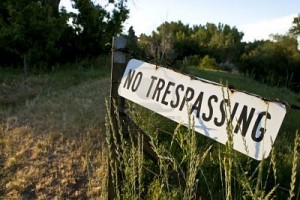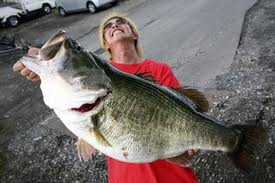Read a sample chapter on how the “Lake of Dreams” was created
How did the lake where the world-record bass was caught come about? Why Kentucky?
The lake was built back in the early 1990s. The site was chosen because of a natural spring that came straight out of the side of a hill. The hilly terrain was perfect for damming up into an excellent-sized 70-acre lake. It already had soil variation and features that made it a perfect site. The spring water not only provided a current of clean fresh water, but it also gave the lake warmer temperatures in the winter and cooler temperatures in the summer, allowing the builder to keep one area of the lake right around 60 degrees year round.
 The site in Kentucky was chosen because of price, location, the real estate market, and its features. It was purchased at an extremely low price after the hog market crashed and a hog farm went bankrupt. It was a nasty stinky place without hope for the future, but the builder saw potential in the form of the lake. The hog sheds were converted to circulating tanks and stations to raise bait fish.
The site in Kentucky was chosen because of price, location, the real estate market, and its features. It was purchased at an extremely low price after the hog market crashed and a hog farm went bankrupt. It was a nasty stinky place without hope for the future, but the builder saw potential in the form of the lake. The hog sheds were converted to circulating tanks and stations to raise bait fish.
Some have asked why the builder did not choose California to build the record bass lake. Why not California?
The builder, although having lived in California for 10 years, knew that real estate prices and land there was very expensive. Additionally, code for building a house, much less a lake, was very rigid and difficult. One would have a great degree of difficulty building a 3 acre lake in California, much less a 70-acre lake. Also, it would cost millions, maybe hundreds of millions, depending on where. The best climates in California are also the preferred locations for inhabitants, and thus high real estate prices. The cheaper places are like a desert and too hot to create a good lake. They also lack incoming water sources. In California, water is an expensive commodity and various interest groups are currently fighting over it. Imagine trying to fight for your right to raise one fish with say the City of Los Angeles.
“I still don’t believe a world-record bass could be raised in Kentucky! How is it possible? What did you feed it?”
The formula for raising the world-record bass did not come about over night. The creator used all the existing research and build upon that. The real area of innovation was the fish-to-food ratio. Almost every fisheries scientist goes about lake development with different goals than the goal of raising one record fish.
The primary goal of fisheries scientists is to create a balanced fishery for recreation. That means a lake that contains catfish, carp, musky, walleye, bass, bluegill, trout, and other varieties. The problem is that all these various fish end up competing against one another for a limited supply of baitfish.
In stark contrast to this traditional approach to fisheries, I developed a new methodology that focuses on growing record bass only. I spent years and piles of time and cash to merely feed a few fish. Years went by before I even put bass in the lake.
I stocked the lake with threadfin shad, fat head minnows, golden shiners, chub suckers, trout, bluegill, redear, and a few other species of bait fish. I learned that the bass fed primarily on the threadfin, bluegill, redear, chub suckers and trout.
 The real secret in this fish-to-food ratio is the incredible quantity of food required to raise a bass of this size. Also, chub suckers and trout are key to take a 15 or 18 pound bass into the 20+ pound size. An 18-pound bass will not grow to 27 pounds by eating threadfin shad. Chub suckers are big, long, thin, and easy to swallow. They have no way to defend themselves against a big bass, so they are consumed easily with very little expenditure of energy on the part of the bass. The same is true with stocker trout. However, stocker trout cannot tolerate temperatures much above 70 degrees Fahrenheit. That is why you need a deeper lake or mountainous area to have a bass lake like this. You cannot put stocker trout in Lake Fork, for example, unless it was seasonal (winter).
The real secret in this fish-to-food ratio is the incredible quantity of food required to raise a bass of this size. Also, chub suckers and trout are key to take a 15 or 18 pound bass into the 20+ pound size. An 18-pound bass will not grow to 27 pounds by eating threadfin shad. Chub suckers are big, long, thin, and easy to swallow. They have no way to defend themselves against a big bass, so they are consumed easily with very little expenditure of energy on the part of the bass. The same is true with stocker trout. However, stocker trout cannot tolerate temperatures much above 70 degrees Fahrenheit. That is why you need a deeper lake or mountainous area to have a bass lake like this. You cannot put stocker trout in Lake Fork, for example, unless it was seasonal (winter).
Another factor is that most people who attempt to raise a record like this end up having a fish farm with high yield, but without the size. You have to harvest, harvest, harvest and keep the population down. It is a lot of work to keep out all of the small bass and competing fish.
Lastly, you have to feed your baitfish even more than you feed your bass. You want big bass? You have to feed them big baitfish that they do not have to work to eat. How do you get big lazy baitfish? You have to feed them constantly! Threadfin will stay relatively small unless they have the right ingredients in the lake. Also, gizzard shad and other shad species may actually impede bass growth in various ways. The same is true for fish like crappie. They can be food for bass, sure, but they also end up competing at various levels and crowd out the bass. They are fast and more difficult to eat than a chub sucker. (I could talk about this for hours, but I will end the answer here. The real fisheries biologists will debate me for hours.) In summary, with the right conditions and fish-to-food ratio, you can grow a world-record bass anywhere.
“How many people have fished the Lake of Dreams?”
One person. A few others have tried but a gun was discharged and they ran away and have not been back since. Three people have now fished the lake for a handful of hours. A world-record was landed, a Kentucky state record, and one poacher ran off with an 11-pound bass.
“How much money did it take to build and stock the lake?”
I don’t really want to answer this question. A lot! The angry wife in the book says something about $100,000, but that is because she was ignorant about the extent of the actual cost. In her mind, $100,000 was the biggest number she could fathom.
“Does the behemouth come when you call it?”
No. Contrary to the expectation that a fed fish will come at the dinner bell, this is not always true. Twice, the fish came and fed at the time when the feeders went off. One time, the fish was caught under these circumstances. This is another reason why the fish was not submitted to the IGFA for certification. They have a rule about not chumming the water. The water was clearly being chummed with bait at the time of the catch. Despite this incident, the fish is wild and does not come around on call.
“How fat is a behemouth?”
 A behemouth bass is fat, huge, but not as fat as you would think. See the picture of the Lake Biwa world-record bass. It is not that fat either. It’s just big. The behemouth was more proportionate than expected also.
A behemouth bass is fat, huge, but not as fat as you would think. See the picture of the Lake Biwa world-record bass. It is not that fat either. It’s just big. The behemouth was more proportionate than expected also.
“Was the dam ever repaired?”
Yes.
“Is this world-record behemouth bass still alive?”
Yes.
How do you keep out poachers?
The property is naturally well-hidden and surrounded by barbed-wire fence. It has video surveillance, but I must admit, it is not secured like Area 51. Warning shots have been fired on three occasions. There are people who know where the lake is now. In case you are wondering, someone is there 24/7—not to fish—but to maintain and protect the lake.
Have you considered having the Bassmaster Classic at the “Lake of Dreams”?
Yes, it is an awesome idea to have the Bassmaster Classic at the best fishery in the world. It would be incredible to have some kind of tournament there. However, the current format for the Bassmaster Classic would not work at this small lake. This lake would be better suited for a Lake Dixon style big bass hall of fame tournament. You get a rental boat and trolling motor and one hour in each quadrant.
How important are genes in growing a world-record bass?
Not as important as the fisheries people think. Think about it this way, you can spend $10 million in trying to isolate some “giant” bass genes or you can take out a couple buckets of chub suckers. Which bass will grow faster? The bass under the microscope or the fish being fed?
It just goes to prove that the right fish-to-food ratio is the key to growing giant bass. Some of these biologists spend all this money on gene studies but then they release these fish into waters with crappie, sauger, walleye, white bass, alligators, and other competitors. How can the fish compete to grow to giant size in this environment? Therefore, food and environment are always more important factors than genetics. However, genetics have some significance. Long life is probably also more of an important factor than genes. Take a look at the bass in Lake of the Ozarks from American BeheMouth. The two 15-pound northern bass grew to this size because they were able to grow old without being caught. It’s not because they had perfect genes. After all, they were not even super bass or Florida-strain bass. These were just northern bass, not known for growing big at all.
